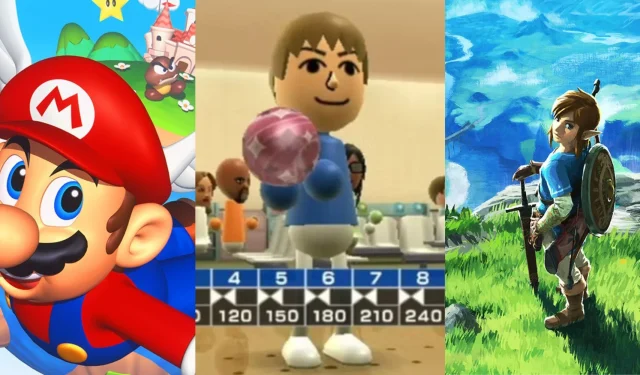
Overview
- The original Super Mario Bros. marked a transformative moment in gaming history upon its release on the NES.
- Super Mario World on the SNES showcased innovative graphics, music, and level designs that set new standards for the franchise.
- Luigi’s Mansion for the GameCube offered a fresh perspective within the Mario universe, ultimately developing a devoted fan base.
Launch titles play a pivotal role in the success of any new video game console. Prospective buyers are often motivated by the promise of thrilling games available at launch. Understanding this dynamic, Nintendo has consistently curated an impressive array of high-quality launch titles for its platforms, whether they be home consoles or handheld devices. Here, we explore the standout games from Nintendo’s history that have shaped expectations for console launches.
Super Mario Bros.
Nintendo Entertainment System

Launched on October 18, 1985, Super Mario Bros. is heralded as one of the most iconic video games ever. It demonstrated that video games could offer expansive, engaging experiences that captivated audiences worldwide. Initially bundled with the Nintendo Entertainment System, it became synonymous with the console’s success.
The lasting appeal of Super Mario Bros. solidified its position as the NES’s flagship title, driving sales long after its release. Although the Famicom version emerged two years prior in Japan, its North American debut firmly established it as a key player in the market.
Super Mario World
Super Nintendo Entertainment System

Following the monumental success of the NES, Nintendo ensured a Mario title would grace its Super Nintendo Entertainment System at launch. Super Mario World, released in 1990, became the quintessential launch title, pushing the boundaries of graphics, sound, and gameplay.
This installment advanced the series with polished sprites, intricate musical scores, and innovative power-ups, like the fan-favorite Yoshi. Super Mario World wasn’t just a game; it was a major force in the Console Wars, helping Nintendo gain an edge over competitors like the Sega Genesis.
Tetris
Game Boy

While the original Game Boy debuted with Super Mario Land, the global anticipation for this title was dampened due to the lengthy wait. Instead, gamers were drawn to the simplicity and charm of Tetris, which came bundled with the handheld.
Nintendo smartly marketed Tetris as a suitable companion for the Game Boy, as the portable format rejuvenated the classic puzzle game. Even after its initial release five years earlier, Tetris thrived on the Game Boy, becoming a defining title for the system.
Super Mario 64
Nintendo 64

As 3D graphics began influencing the gaming landscape in the mid-90s, Nintendo stepped up its game with the Nintendo 64. Launching with Super Mario 64, this title revolutionized platforming and demonstrated the capabilities of 3D gaming.
Super Mario 64 showcased freeform movement made possible by the analog stick, providing an entirely new way to navigate game worlds. Its immediate popularity provided a compelling reason for consumers to choose the Nintendo 64 even amidst strong competition from the PlayStation.
Luigi’s Mansion
Nintendo GameCube

With the launch of the sixth-generation console, the Nintendo GameCube, Nintendo opted for a distinct direction by introducing Luigi’s Mansion. Departing from traditional platforming, this adventure/horror game centered around Luigi brought fresh gameplay mechanics that surprised audiences.
Although initial reviews were mixed, Luigi’s Mansion gradually garnered a loyal fan base. Its inventive design proved that the Mario franchise could successfully explore new genres, paving the way for future titles.
Wii Sports
Nintendo Wii

In the mid-2000s, the Nintendo Wii disrupted the gaming industry with its innovative motion controls. To showcase this new technology effectively, Nintendo bundled Wii Sports with the console, allowing players to experience the fun and accessibility of motion gaming right out of the box.
Wii Sports‘s popularity was undeniable, playing an essential role in the console’s emergence as a cultural phenomenon, even becoming the definitive game for many casual players.
Nintendo Land
Nintendo Wii U

Nintendo Land, while not as universally appealing as Wii Sports, still met expectations as the Wii U’s primary pack-in game. It aimed to familiarize players with the unique features of the console through a series of engaging mini-games.
With 12 diverse mini-games themed around beloved Nintendo franchises, including Super Mario Bros. and The Legend of Zelda, Nintendo Land demonstrated the potential of the Wii U GamePad, solidifying its place in gaming history.
The Legend Of Zelda: Breath Of The Wild
Nintendo Switch

After years of anticipation, The Legend of Zelda: Breath of the Wild finally launched alongside the Nintendo Switch on March 3, 2017. Initially intended for the Wii U, its delay allowed Nintendo to perfect this stunning open-world experience.
Offering players rich storytelling and vast exploration, Breath of the Wild became an instant classic, attracting a wide range of gamers to the Switch. The question remains: will the anticipated Nintendo Switch 2 debut with a title that matches the ambition and innovation of Breath of the Wild?




Leave a Reply